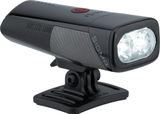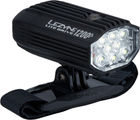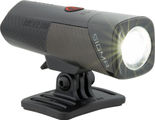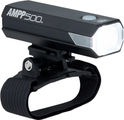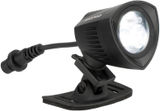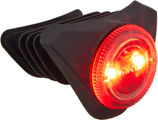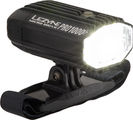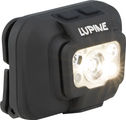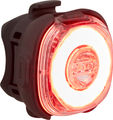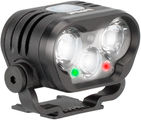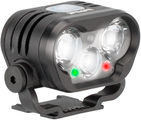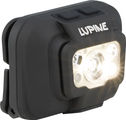Helmet Lights
OUR Helmet Lights RECOMMANDATIONS
Our Suggestions
When to use a helmet light
Note: StVZO regulations apply only in Germany and do not apply elsewhere. Please consult with your local municipality for information regarding public safety regulations.
First and foremost, helmet lights are not bicycle lights. They do not have StVZO approval because the requirements for lights intended for trails are often completely contradictory to lights permitted for street use. An example of one difference: StVZO standards demand that street bike lights possess certain horizontal limits to prevent dazzling oncoming traffic. This requirement is entirely counterproductive in wooded areas, as it prevents the light from reaching maximum illumination in all directions, thereby heightening the risk of damage or injury from obstacles such as low-hanging tree branches. Lamps without StVZO approval (denoted by the K mark: a wavy line, the capital letter K and a number) may not be used in street traffic either as front or rear lights. To make your way safely and legally to mountain biking trails, we recommend supplementing your helmet light with compactbattery lighting at the front and back of the bike. Sidenote: E-MTBs sometimes include Headlights with street approval as well as an enormous high beam, which adapts well to use in the woods.
Where to install? The right spot for your helmet light
In general, mounting your helmet light on an MTB-helmet is the optimum solution for extreme mountain biking in the dark. The cone of light falls along your line of vision and allows you to ride with increased foresight and speed. If the lamp is mounted on the Handlebar, the light cone falls rather onto your steering path. The latter option can be especially unsteady on winding trails, and can make navigating them difficult. That said, helmet mounting also has its disadvantages: powerful headlamps are oftentimes heavier due to the large size of the battery, and carrying additional weight on the helmet can quickly become uncomfortable. However, you can carry large batteries in a backpack or jersey pocket and connect them via an extension cable. The optimal combination, therefore, is an extremely bright lamp attached to the handlebars with its battery mounted onto the frame, and a smaller lightweight lamp installed on the helmet.
Tip:
When putting together a combination of both helmet and handlebar lights, make sure to test out how much weight you can comfortably carry on your helmet, and make sure to determine if handlebar mounting is even an option for your bike.
A helmet light battery must correspond to its output
Those that require a lot of power naturally require a lot of energy. Much like automotive headlamps, bright helmet lights also need a lot of energy to achieve their maximum output. Performance and battery life can vary dramatically depending on which mode is used. For example, the maximum 1,900 lumen bright Lupine Piko with its large RX7 Smartcore battery (6.9 Ah) achieves between 2.5 and 160 hours of operating time depending on the power level. Lupine supplies almost all of its lights with different battery capacities. Bikepackers and mountain bikers who spend long nights on the road can bring extra battery packs with them, while occasional night riders can save on money and weight with smaller batteries. Generally speaking, it is a good idea to reserve your light’s maximum output for trails and to switch to a dimmer setting on your way there. Most lamps have at least three to five hours of operating time, which is more than enough for an after-work jaunt or an early morning ride.
Tip:
Those who ride in negative temperatures should carry batteries on the body and connect them via an extension cable. The rider’s body heat extends the battery’s lifespan and prevents its energy from draining too quickly. Lights, on the other hand, shine even brighter in cold weather.
Helmet light accessories – useful features for more fun and better handling on trails
Lamps and batteries aren’t the only things that dictate how fun a night ride will be. Having the right accessories also makes a big difference. For example, the Sigma Buster 2000 HL LED has a wireless remote control that lets you switch between output levels and turn the light on and off. This helps your hands stay where they always belong: on the handlebars. You can also attachthe headlight onto an action cam mount using the included adapter. Lupine lights bearing the nickname "R(emote)" include this feature. The Blika R, for example, can not only be remotely controlled via Bluetooth--it also has green and red light functions and offers programmable light modes from spot to cone via app. Thenavigation specialist Garmin boasts even more smartphone integration with its Varia UT 800 Trail Edition. It can be paired with select Garmin GPS devices and automatically adjust lamp intensity based on navigation data such as ambient light conditions and driving speed.
Beware of glare!
No matter where you are, pay attention to your light’s brightness at all times. Its glare can be not only unpleasant but actually painful for passing traffic. Therefore it’s recommended to dim lights not only for oncoming traffic, but basically any place where you can expect to pass others. Don't forget: always use a StVZO light on your way to and from trails.
Be conscious of the environment
Night riding is not without its ecological impacts. While twilight and night-time periods are times of rest for diurnal animals, they’re a fundamentally important active time for nocturnal animals to acquire food, reproduce or otherwise. In a densely-populated country like Germany with severely fragmented wildlife habitats and little space for expansion, local fauna is tightly constricted. Night rides will always affect and disrupt wildlife activity, therefore be considerate! Ecologically valuable habitats such as conservation areas, nature reserves or national parks are taboo for night riding. Paradoxical as it may sound, winter is no sensible time for night riding in terms of ecology, even if it seems more appealing due to shortened days. Disturbances in this time make it more difficult for wild animals to survive. That said, stay close to populated areas and avoid riding during night hours to give wildlife its needed space.

